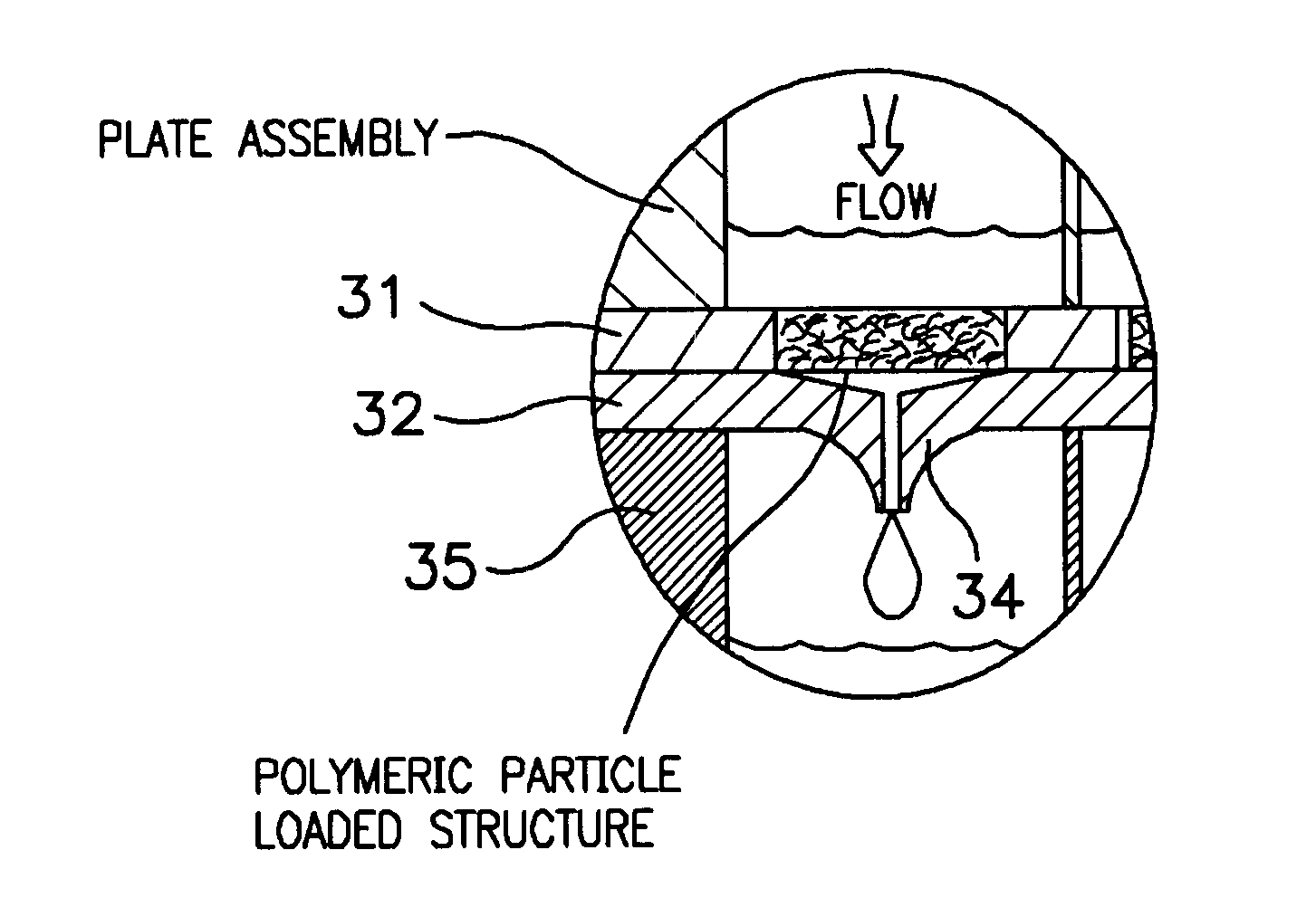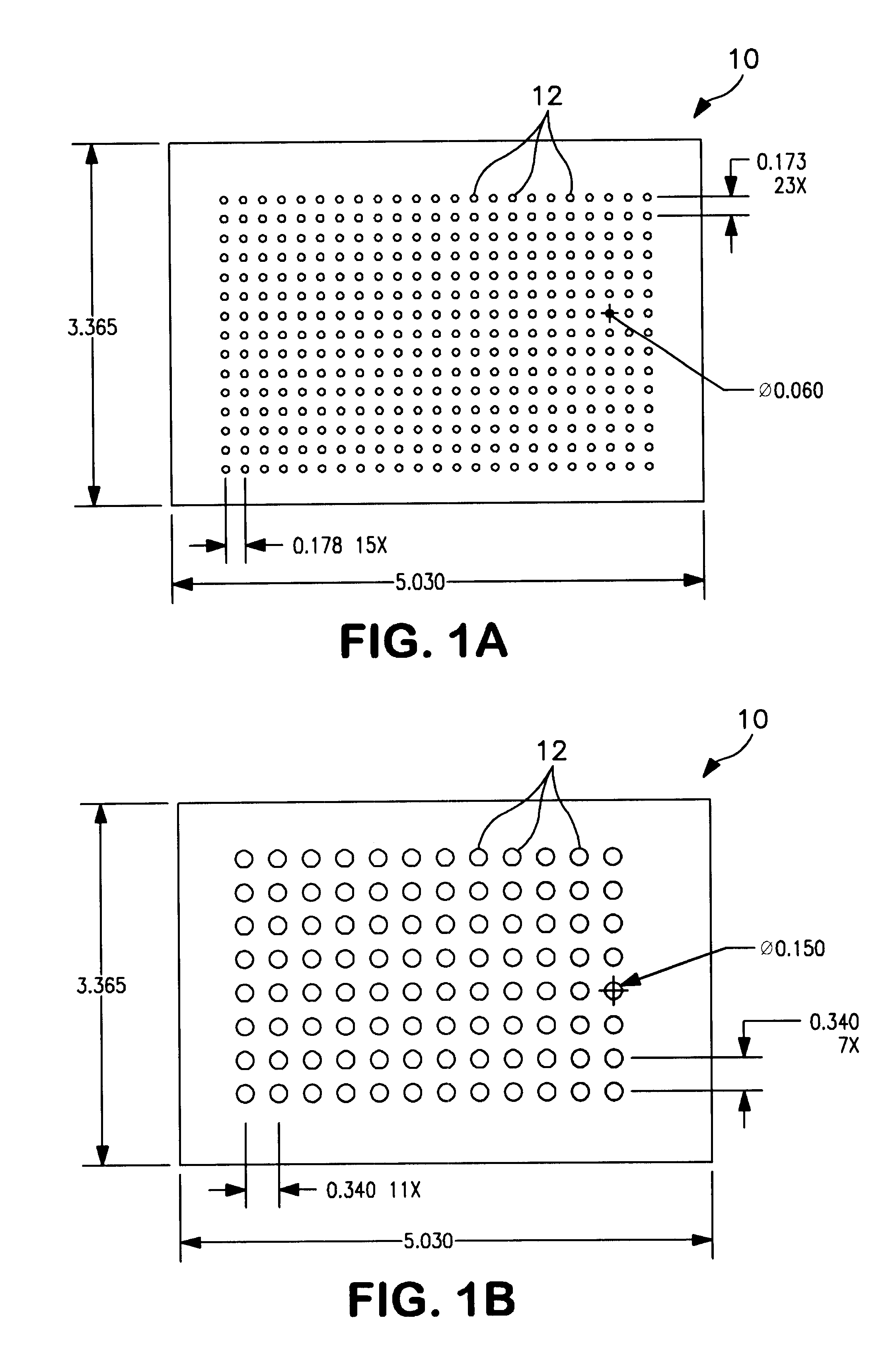High density cast-in-place sample preparation card
a sample preparation and high density technology, applied in the field of high density cast-in-place sample preparation cards, to achieve the effect of convenient removal and high throughpu
- Summary
- Abstract
- Description
- Claims
- Application Information
AI Technical Summary
Benefits of technology
Problems solved by technology
Method used
Image
Examples
example 1
C18, 15 um Silica Particle Loaded Membrane Cast in Place
In a small vessel, 10 grams of a 9% (w / w) polysulfone solution (Amoco, P3500) was prepared in N-methyl-2-pyrrolidone. To this, 2 grams of C18, 200 Å, 15 μm silica (Millipore, PN 85864) was added and mixed thoroughly with a spatula. The mixture was allowed to equilibrate for 2 hours at room temperature, then mixed again. Using a pipette or eye dropper, 25-50 μl of casting solution was dispensed into a suitable fixture, such as the recesses of a 3″×5″×0.06″ polypropylene insert pre-drilled with 384 0.1 inch diameter holes at 0.178 inch center spacing which has been taped to a glass plate (substrate). Once added, a bar was drawn over the card surface to ensure that the solution filled the recesses. Care was taken to ensure that bubbles did not form. The device was immersed in water for ca. 0.5 hours. After this period, the unit was removed and a razor blade was used to remove excess polymer. The card was then removed from the glas...
example 2
A polymer solution (about 25 ml) of polysulfone is prepared in N-methylpyrrolidone to about 9% w / w in polymer solids in an about 100 ml beaker. To this solution, particles are added (which may or may not have adsorptive properties) while constantly mixing until the lacquer is of the consistency of plaster (approximately 40% solids and 25,000 cps). Using a flexible spatula, the lacquer is spread into the holes of a predrilled card (same as Example 1) which is being held by the outer edges. Once the holes are filled, the excess on the exterior of both sides is removed such as by scraping, and the card is immersed in a water bath at 80 C. After the structure is precipitated and desolvenated (about 1 hour), the card is removed and the excess polymer above the plane of the card surface is removed such as with a razor blade or wiping with a cloth. The card is then re-immersed and agitated in a water bath for about 5 minutes to remove particulate matter, and is then removed and allowed to ...
example 3
The device of FIG. 3 is placed into the top (spouts facing down) of a common vacuum housing 40 as shown in FIG. 4. It is sealed to a removable lid 42 such as by elastomeric seals 43. A collection tray 35 is underneath within the lower chamber 45. A conditioning solution is added to the upper sample chambers and the vacuum turned on to pull the solution through. Sample is then applied. As the vacuum pulls the sample solution through, the components of interest adsorb to the polymeric structure within the insert, while the contaminants flow into the collection vessel 35. A wash solution is then added to the upper chamber 30 (with the vacuum on) to rinse away trace contaminants. The vacuum is turned off and the collection vessel 35 is replaced with a clean one. The unit is re-assembled and a suitable desorption solution is added to the upper sample chambers. As this solution flows through the insert, it desorbs the components of interest, which are captured by the clean collection vess...
PUM
| Property | Measurement | Unit |
|---|---|---|
| aspect ratio | aaaaa | aaaaa |
| size | aaaaa | aaaaa |
| temperatures | aaaaa | aaaaa |
Abstract
Description
Claims
Application Information
 Login to View More
Login to View More - R&D
- Intellectual Property
- Life Sciences
- Materials
- Tech Scout
- Unparalleled Data Quality
- Higher Quality Content
- 60% Fewer Hallucinations
Browse by: Latest US Patents, China's latest patents, Technical Efficacy Thesaurus, Application Domain, Technology Topic, Popular Technical Reports.
© 2025 PatSnap. All rights reserved.Legal|Privacy policy|Modern Slavery Act Transparency Statement|Sitemap|About US| Contact US: help@patsnap.com



